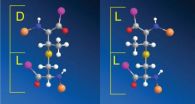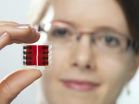(Press-News.org) CHAMPAIGN, Ill. — While working out the structure of a cell-killing protein produced by some strains of the bacterium Enterococcus faecalis, researchers stumbled on a bit of unusual biochemistry. They found that a single enzyme helps form distinctly different, three-dimensional ring structures in the protein, one of which had never been observed before.
The new findings, reported in Nature Chemical Biology, should help scientists find new ways to target the enterococcal cytolysin protein, a "virulence factor that is associated with acute infection in humans," said University of Illinois chemistry and Institute for Genomic Biology professor Wilfred van der Donk, who conducted the study with graduate student Weixin Tang.
Enterococcus faecalis (EN-ter-oh-cock-us faye-KAY-liss) is a normal microbial inhabitant of the gastrointestinal tracts of humans and other mammals and generally does not harm its host. Some virulent strains, however, produce cytolysin (sigh-toe-LIE-sin), a protein that, once assembled, attacks other microbes and kills mammalian cells.
"The cytolysin protein made by Enterococcus faecalis consists of two compounds that have no activity by themselves but when combined kill human cells," van der Donk said. "We know from epidemiological studies that if you are infected with a strain of E. faecalis that has the genes to make cytolysin, you have a significantly higher chance of dying from your infection." E. faecalis contributes to root canal infections, urinary tract infections, endocarditis, meningitis, bacteremia and other infections.
Enterococcal cytolysin belongs to a class of antibiotic proteins, called lantibiotics, which have two or more sulfur-containing ring structures. Scientists had been unable to determine the three-dimensional structure of this cytolysin because the bacterium produces it at very low concentrations. Another problem that has stymied researchers is that the two protein components of cytolysin tend to clump together when put in a lab dish.
Van der Donk and Tang got around these problems by producing the two cytolysin components separately in another bacterium, Escherichia coli (esh-uh-REE-kee-uh KOH-lie), and analyzing them separately.
"The two components are both cyclic peptides, one with three rings and the other with two rings," van der Donk said. "Curiously, a single enzyme makes both compounds."
In a series of experiments, the researchers found that one ring on each of the proteins adopted a (D-L) stereochemistry that is common in lantibiotics (see image, above). But the other rings all had an unusual (L-L) configuration, something van der Donk had never seen before.
Scientists had assumed that the enzyme that shaped enterococcal cytolysin, a lantibiotic synthetase, acted like a three-dimensional mold that gave the ring structures of cytolysin the exact same stereochemistry, van der Donk said.
"But we found that the enzyme, enterococcal cytolysin synthetase, makes the rings with different stereochemistry," he said. "I don't know of any other examples where one enzyme can make very similar products but with different stereochemistries."
The researchers don't know how the enzyme accomplishes this feat, but found a clue in the sequence of amino acids that make up the protein rings. The chemical characteristics of the three amino acids in the middle of the ring structure and their proximity to another amino acid, a cysteine, determined whether the rings took on a D-L or L-L stereochemistry.
The researchers tested the idea that the amino acid sequence of the cytolysin protein was guiding the stereochemistry by looking at other lantibiotic proteins with similar sequences. So far, every protein they've tested that has the same sequence characteristics conforms to the pattern they discovered, van der Donk said.
Further tests showed that the cytolysin produced in E. coli had the same anti-microbial and cell-killing potency as the E. faecalis variety.
"Knowing the structure of enterococcal cytolysin and having a method to produce it in relatively large quantities will allow scientists to find out how it kills human cells and, in turn, how we might fight against it," van der Donk said.
INFORMATION:
The National Institutes of Health supported this research. Van der Donk also is a Howard Hughes Medical Institute investigator.
Editor's notes:
To reach Wilfred van der Donk, call 217-244-5360;
email vddonk@illinois.edu.
The paper, "The Sequence of the Enterococcal Cytolysin Imparts Unusual Lanthionine Stereochemistry," is available to the media from the U. of I. News Bureau.
Study: Odd biochemistry yields lethal bacterial protein
2013-01-22
ELSE PRESS RELEASES FROM THIS DATE:
Scientists find gene interactions that make cocaine abuse death 8 times more likely
2013-01-22
COLUMBUS, Ohio – Scientists have identified genetic circumstances under which common mutations on two genes interact in the presence of cocaine to produce a nearly eight-fold increased risk of death as a result of abusing the drug.
An estimated one in three whites who died of cocaine exposure is a carrier of variants that make cocaine abuse particularly deadly.
The variants are found in two genes that affect how dopamine modulates brain activity. Dopamine is a chemical messenger vital to the regular function of the central nervous system, and cocaine is known to block ...
Tiny fossils hold answers to big questions on climate change
2013-01-22
The western Antarctic Peninsula is one of the fastest warming regions on the planet, and the fastest warming part of the Southern Hemisphere.
Scientists have debated the causes of this warming, particularly in light of recent instrumental records of both atmospheric and oceanic warming from the region. As the atmosphere and ocean warm, so the ice sheet (holding an equivalent of 5 metres of global sea level rise, locked up in ice) becomes vulnerable to collapse.
Now research led by Cardiff University published in Nature Geoscience has used a unique 12,000 year long ...
New study examines on/off relationships and 'sex with an ex' among teenagers and young adults
2013-01-22
Los Angeles, CA (January 22, 2013)- A new study finds that nearly half of older teenagers and young adults break up and get back together with previous dating partners and over half of this group have sex as part of the reconciliation process. This study was recently published in the Journal of Adolescent Research, a SAGE journal.
Researchers Sarah Halpern-Meekin, Wendy Manning, Peggy Giordano and Monica Longmore studied data on 792 daters and cohabiters ages 17 to 24, also known as "emerging adults." The researchers studied two relationship patterns specifically – reconciliation ...
New drug protects against side effects of chemotherapy
2013-01-22
A drug developed at Linköping University in Sweden protects against the side effects of cancer treatments while strengthening the effects on the tumour. An international drug evaluation is now starting up on a larger group of patients.
The results of the studies with the compound, known as calmangafodipir, were published in the latest issue of the cancer journal Translational Oncology with Professor Rolf G. G. Andersson as the main author.
The research was initiated on a substance called mangafodipir, which was used as a contrast media in magnetic resonance scans. But ...
Image sensors out of a spray can
2013-01-22
This press release is available in German. Image sensors are at the core of every digital camera. Before a snapshot appears on the display, the sensors first convert the light from the lens to electrical signals. The image processor then uses these to create the final photo.
Many compact and cellphone cameras contain silicon-based image sensors produced using CMOS (complementary metal oxide semiconductor) technology. Prof. Paolo Lugli and Dr. Daniela Baierl from TUM have developed a cost-effective process to improve the performance of these CMOS sensors. Their approach ...
Public acceptance of climate change affected by word usage
2013-01-22
Public acceptance of climate change's reality may have been influenced by the rate at which words moved from scientific journals into the mainstream, according to anthropologist Michael O'Brien, dean of the College of Arts and Science at the University of Missouri. A recent study of word usage in popular literature by O'Brien and his colleagues documented how the usage of certain words related to climate change has risen and fallen over the past two centuries. Understanding how word usage affects public acceptance of science could lead to better science communication and ...
LSUHSC research provides new drug target for Her-2 related breast cancer
2013-01-22
New Orleans, LA – Research led by Dr. Suresh Alahari, the Fred Brazda Professor of Biochemistry and Molecular Biology at LSU Health Sciences Center New Orleans and its Stanley S. Scott Cancer Center, details exactly how the Her2 cancer gene promotes the progression and spread of breast cancer cells. The inactivation of a tumor suppression gene called Nischarin is among the mechanisms identified. The findings provide a new therapeutic target to block the function of Her2. The research was published in Cancer Research, OnlineFirst on January 21, 2013.
About 30% of breast ...
Bioethics leader calls for bold approach to fighting obesity
2013-01-22
(Garrison, NY) Arguing that obesity "may be the most difficult and elusive public health problem the United States has ever encountered" and that anti-obesity efforts having made little discernible difference, Daniel Callahan, co-founder and President Emeritus of The Hastings Center, proposes a bold and controversial approach to fighting the epidemic.
Callahan says that the public health community can learn from one of the most successful public health campaigns: the anti-smoking campaign. A primary strategy has been to stigmatize smokers, he says, making it clear that ...
From dark hearts comes the kindness of mankind
2013-01-22
The kindness of mankind most likely developed from our more sinister and self-serving tendencies, according to Princeton University and University of Arizona research that suggests society's rules against selfishness are rooted in the very exploitation they condemn.
The report in the journal Evolution proposes that altruism — society's protection of resources and the collective good by punishing "cheaters" — did not develop as a reaction to avarice. Instead, communal disavowal of greed originated when competing selfish individuals sought to control and cancel out one ...
SEC-mandated XBRL data at risk of being irrelevant to investors and analysts
2013-01-22
NEW YORK - January 22, 2013 - In 2009, the Securities and Exchange Commission mandated that public companies submit portions of annual (10-K) and quarterly (10-Q) reports—in a digitized format known as eXtensible Business Reporting Language (XBRL). The goal of this type of data was to provide more relevant, timely, and reliable "interactive" data to investors and analysts. The XBRL-formatted data is meant to allow users to manipulate and organize the financial information according to their own purposes faster, cheaper, and more easily than current alternatives.
But how ...

